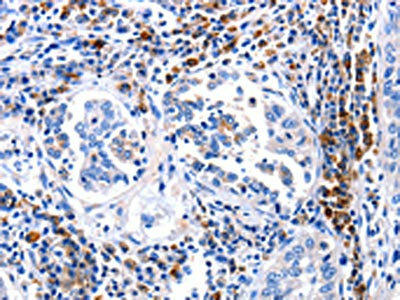Description
| Antibody Name: | DOK3 Antibody (PACO14350) |
| Antibody SKU: | PACO14350 |
| Size: | 50ul |
| Host Species: | Rabbit |
| Tested Applications: | ELISA, WB, IHC |
| Recommended Dilutions: | ELISA:1:1000-1:2000, WB:1:200-1:1000, IHC:1:25-1:100 |
| Species Reactivity: | Human |
| Immunogen: | Fusion protein of human DOK3 |
| Form: | Liquid |
| Storage Buffer: | -20°C, pH7.4 PBS, 0.05% NaN3, 40% Glycerol |
| Purification Method: | Antigen affinity purification |
| Clonality: | Polyclonal |
| Isotype: | IgG |
| Conjugate: | Non-conjugated |
 | Gel: 10%SDS-PAGE, Lysate: 40 μg, Lane: Human notum skin cancer tissue, Primary antibody: PACO14350(DOK3 Antibody) at dilution 1/250, Secondary antibody: Goat anti rabbit IgG at 1/8000 dilution, Exposure time: 30 seconds. |
 | The image on the left is immunohistochemistry of paraffin-embedded Human lung cancer tissue using PACO14350(DOK3 Antibody) at dilution 1/25, on the right is treated with fusion protein. (Original magnification: x200). |
| Background: | DOK3 gene maps to chromosome 5q35.3. Dok3 was tyrosine phosphorylated by Src family members Lck, Fyn, and Lyn. Immunoprecipitation studies showed that Dok3 bound inhibitors SHIP and Csk but did not bind RasGAP. Dok3 binding to SHIP occurred via the SH2 domain. Dok3 also bound Csk via the Csk SH2 domain with possible involvement of the Csk SH3 domain as well.DOK proteins are enzymatically inert adaptor or scaffolding proteins. They provide a docking platform for the assembly of multimolecular signaling complexes. DOK3 is a negative regulator of JNK signaling in B-cells through interaction with INPP5D/SHIP1. May modulate ABL1 function |
| Synonyms: | docking protein 3 |
| UniProt Protein Function: | DOK3: docking proteins are enzymatically inert adaptor or scaffolding proteins. They provide a docking platform for the assembly of multimolecular signaling complexes. DOK3 is a negative regulator of JNK signaling in B-cells through interaction with SHIP. May modulate Abl function. Upon tyrosine phosphorylation, Dok3 interacts with CSK and SHIP via their SH2 domains. Both pY381 and pY398 are required for interaction with SHIP. Only pY381 is required for interaction with CSK. Binds ABL through the PTB domain and in a kinase-dependent manner. On IL2 stimulation, phosphorylated on C-terminal tyrosine residues possibly by Src kinases. Does not interact with RasGAP. Four isoforms of the human protein are produced by alternative splicing. |
| UniProt Protein Details: | Protein type:Adaptor/scaffold Chromosomal Location of Human Ortholog: 5q35.3 Molecular Function:protein binding |
| UniProt Code: | Q7L591 |
| NCBI GenInfo Identifier: | 84029599 |
| NCBI Gene ID: | 79930 |
| NCBI Accession: | Q7L591.2 |
| UniProt Secondary Accession: | Q7L591,Q8N864, Q9BQB3, Q9H666, E9PAT0, H7BXS0, |
| UniProt Related Accession: | Q7L591 |
| Molecular Weight: | 24,737 Da |
| NCBI Full Name: | Docking protein 3 |
| NCBI Synonym Full Names: | docking protein 3 |
| NCBI Official Symbol: | DOK3 |
| NCBI Official Synonym Symbols: | DOKL |
| NCBI Protein Information: | docking protein 3 |
| UniProt Protein Name: | Docking protein 3 |
| UniProt Synonym Protein Names: | Downstream of tyrosine kinase 3 |
| Protein Family: | Docking protein |
| UniProt Gene Name: | DOK3 |
| UniProt Entry Name: | DOK3_HUMAN |






